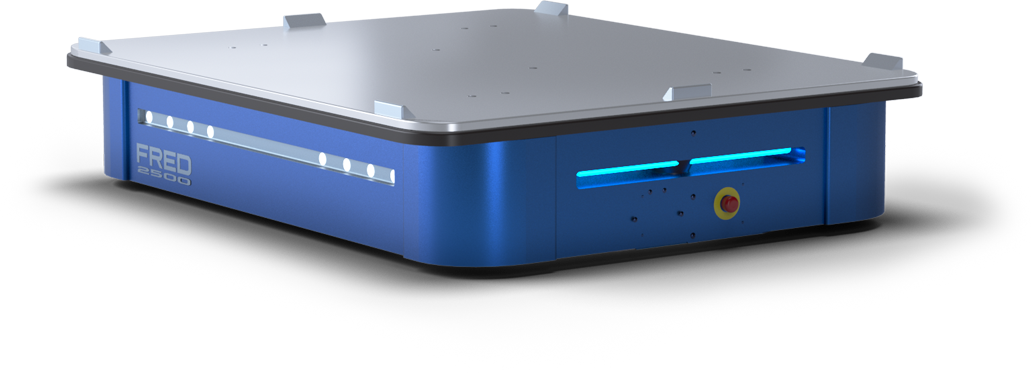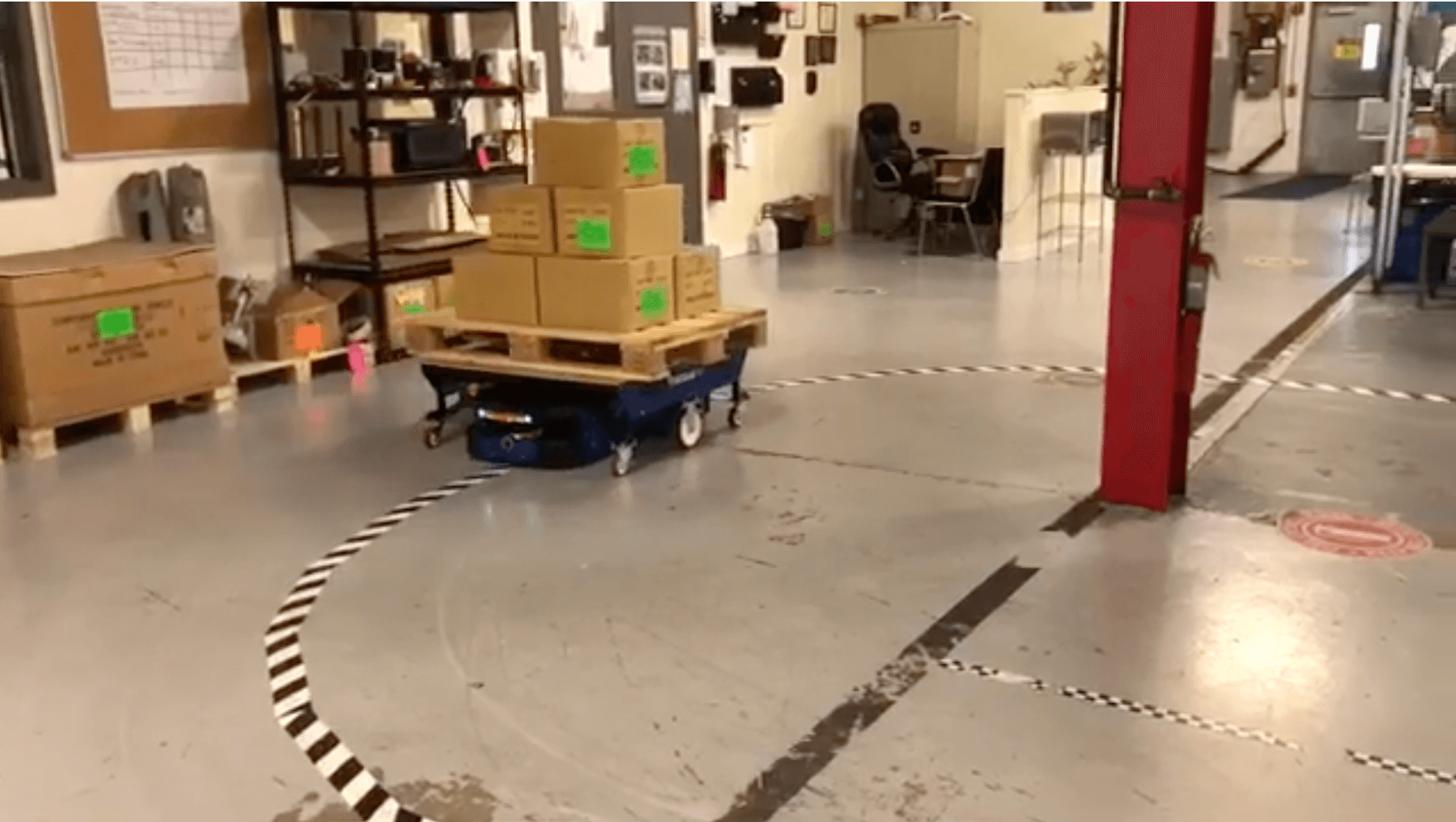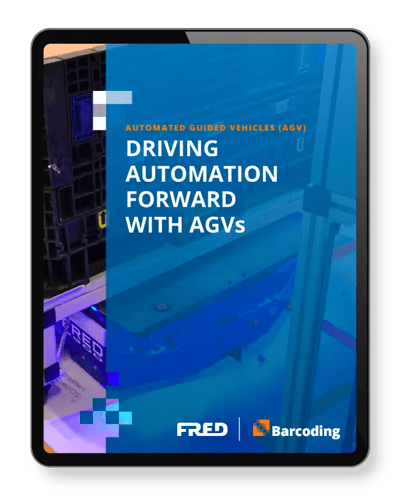Businesses of every size—and across nearly every industry—are turning to AGVs to solve their material-movement challenges. The many benefits AGVs bring to the warehouse or factory floor are increasing year after year, and with that, more AGVs are available of varying sizes and complexities. The one thing they all have in common is that they require a method of navigation; a way for them to make their way around a factory floor or other work space. What kind of navigation system is right for you? Well, it depends on your needs, your space and your budget. This article discusses the different kinds of navigation systems, including the one used by our very own FRED/FREDDiE.
The first AGV navigation system utilized a wire attached to a ceiling that moved with the AGV as it made its way around a factory. Navigation systems have made major advancements since then, but the principle remains the same: it must have some way of being guided along a pre-set path. AGVs aren’t sentient and must be told where to go (well, for now anyways—who knows what the future holds).
So what kind of navigation system is right for you? Just like AGVs vary in complexity, so do their navigation systems. For example, if your system is required to communicate with the cloud—or a local control system—the vehicle will need access to some sort of wireless connectivity. Bluetooth has limited range. WiFi has more range, but can still struggle in larger environments. GPS may not work indoors at all.
If your facility isn’t set up for wireless connectivity—or if you don’t want the hassle, expense and potential disruption of maintaining such a system—then look for an AGV that won’t require it. As have some other AGVs on the market, FRED and FREDDiE are designed to operate fully independently of other systems They can be modified with on-board electronics that do communicate. But they’re also ready to operate out of the box.
Before we talk more about FRED/FREDDiE, let’s discuss some of the different navigation systems:
Laser Guided
Laser-guided vehicles are one of the more flexible AGV systems because they don’t rely on tracks that need to be installed or moved. LGVs use an elevated navigational laser to guide them, wherein laser sensors in the vehicle interact with “targets” mounted along the path. The range between the sensors and targets is generally around 100 feet, and the sensors receive signals that triangulate the vehicle’s position. Like we mentioned, laser guided systems allow for flexibility and easy modification, but they can be incredibly expensive to purchase and install, and usually require a specialist for installation. The lasers are also subject to accidentally being blocked by tall loads.
QR Code
One of the newer methods of navigation, QR code navigation guides AGVs along its coded path using QR codes to initiate starts, stops and turns. Individual codes are programmable and read by the AGV as it makes its way along the floor. This method can be very flexible, but sometimes the technology involved can be complicated and involves special software for the AGV.
Inductive Wire
Inductive wire guidance uses wires embedded in the floor for both steering and navigation. This is one of the oldest forms of AGV guidance and still among the most popular, as the wires can be sealed for use in tough environments. Because they’ve been around a long time, the hardware is proven and accurate, but the AGVs are usually pretty limited in speed. This form of navigation is also hard to alter if path changes are needed, and requires antennas at both ends so that the AGV can travel back and forth.
Natural Feature
An AGV with natural feature navigation requires no magnetic tap or RFID tags to guide its way through a facility. It’s called “natural feature” because it requires no changes in its environment in order to navigate, therefore it’s flexible in where it can operate. The AGV’s route is uploaded to a computer where it can be modified to precision. This is beneficial if you need AGVs that move at high speeds, but they aren’t suitable for all facilities and they can’t be used outdoors. The technology can also be expensive and requires specialists for installation, coding and troubleshooting.
Magnetic Spot
Magnetic spot navigation technology involves cylindrical magnetic spots embedded in the floor. The AGV follows a Computer-Aided Design (CAD) drawing uploaded to its onboard computer and uses magnets to recalibrate its steering angle as it operates. These spots can be incredibly durable, but installation requires the expertise of a vendor and rerouting will likely require new CAD drawings. However, magnetic spot technology has the advantage of being able to be used outdoors, so if you need your AGV primarily for outdoor tasks, this might be the navigation for you.
Free Navigation
“Free” navigation, as the name suggests, is AGV navigation that doesn’t use tape, wires or reflectors. Instead, the AGV “learns” the area and localizes itself in the environment—you won’t need to teach it. It’s relatively new and cutting edge technology, and in fact might represent the future of robotics. However, because it’s so new, navigation gets complicated in environments that are chaotic or always changing. Plus, even though it’s called free navigation, the technology is anything but—it’s one of the more expensive options out there.
Magnetic Tape
One of the easiest methods of AGV navigation is magnetic tape, especially the kind of tape used by FRED and FREDDiE. Although tape has a reputation in the AGV world for being difficult to install and change, FRED/FREDDiE is redefining what it means to have an easy-to-use AGV—including installation. Both AGVs will follow a magnetic tape that only takes about two hours to install, and CAD drawings aren’t even necessary. And although a lot of magnetic tape can be difficult to alter when you need to change routes, FRED/FREDDiE’s tape is specially-designed to make this task easier. Plus, you won’t need outside help for installation or changes. (Unless you just want it.) Here’s an example of FRED moving along the magnetic tape:
There isn’t one single navigation technology better than the rest. Each has its advantages and disadvantages. But your AGV’s navigation technology will determine ease and cost of rerouting. If you expect to experiment with routing or occasionally change your workflows, then you’ll be best off with an AGV that either follows a magnetic strip or uses lasers. We designed FRED and FREDDiE to follow a strip of magnetic tape because it’s flexible, accurate, affordable and makes for incredibly quick and easy installations without requiring vendor assistance. In fact, you can install or reroute FRED within two hours, as seen in the video below. And while not free, additional magnetic tape will never break the bank as it costs roughly $1 per foot.
FRED/FREDDiE’s magnetic tape may be right for your needs. Or, you may need another kind of navigation. There could be questions you should be asking your vendor that we’ve not included in this article. We’re available to talk through your challenges and opportunities, and help make sure you’re asking the right questions and getting the right answers, whether from us or another vendor. Ultimately, we’re interested in propelling warehouse and factory automation forward—and FRED/FREDDiE might be perfect to lead the way.
Automation Questions?
Businesses across many industries are now turning to automation technologies as powerful solutions to once unforeseeable material-movement challenges. We’re here to help you navigate the automation landscape, and drive your business forward. To learn more about how FRED and FREDDiE provide easy-to-implement solutions to complex challenges, contact an ASI Automation specialist today at info@fredagv.com.


